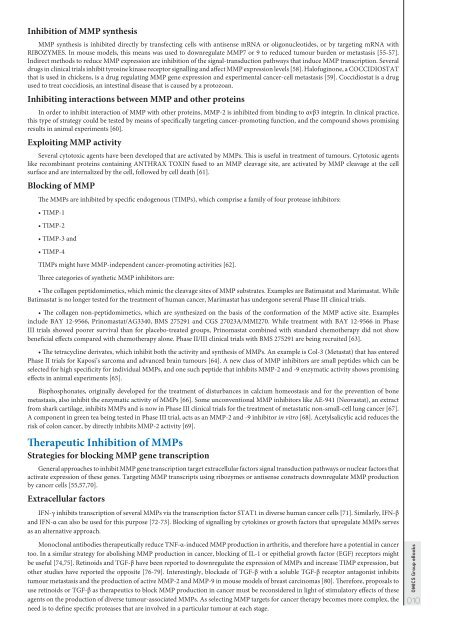You also want an ePaper? Increase the reach of your titles
YUMPU automatically turns print PDFs into web optimized ePapers that Google loves.
Inhibition of MMP synthesis<br />
MMP synthesis is <strong>in</strong>hibited directly by transfect<strong>in</strong>g cells with antisense mRNA or oligonucleotides, or by target<strong>in</strong>g mRNA with<br />
RIBOZYMES. In mouse models, this means was used to downregulate MMP7 or 9 to reduced tumour burden or metastasis [55-57].<br />
Indirect methods to reduce MMP expression are <strong>in</strong>hibition of the signal-transduction pathways that <strong>in</strong>duce MMP transcription. Several<br />
drugs <strong>in</strong> cl<strong>in</strong>ical trials <strong>in</strong>hibit tyros<strong>in</strong>e k<strong>in</strong>ase receptor signall<strong>in</strong>g and affect MMP expression levels [58]. Halofug<strong>in</strong>one, a COCCIDIOSTAT<br />
that is used <strong>in</strong> chickens, is a drug regulat<strong>in</strong>g MMP gene expression and experimental cancer-cell metastasis [59]. Coccidiostat is a drug<br />
used to treat coccidiosis, an <strong>in</strong>test<strong>in</strong>al disease that is caused by a protozoan.<br />
Inhibit<strong>in</strong>g <strong>in</strong>teractions between MMP and other prote<strong>in</strong>s<br />
In order to <strong>in</strong>hibit <strong>in</strong>teraction of MMP with other prote<strong>in</strong>s, MMP-2 is <strong>in</strong>hibited from b<strong>in</strong>d<strong>in</strong>g to αvβ3 <strong>in</strong>tegr<strong>in</strong>. In cl<strong>in</strong>ical practice,<br />
this type of strategy could be tested by means of specifically target<strong>in</strong>g cancer-promot<strong>in</strong>g function, and the compound shows promis<strong>in</strong>g<br />
results <strong>in</strong> animal experiments [60].<br />
Exploit<strong>in</strong>g MMP activity<br />
Several cytotoxic agents have been developed that are activated by MMPs. This is useful <strong>in</strong> treatment of tumours. Cytotoxic agents<br />
like recomb<strong>in</strong>ant prote<strong>in</strong>s conta<strong>in</strong><strong>in</strong>g ANTHRAX TOXIN fused to an MMP cleavage site, are activated by MMP cleavage at the cell<br />
surface and are <strong>in</strong>ternalized by the cell, followed by cell death [61].<br />
Block<strong>in</strong>g of MMP<br />
The MMPs are <strong>in</strong>hibited by specific endogenous (TIMPs), which comprise a family of four protease <strong>in</strong>hibitors:<br />
• TIMP-1<br />
• TIMP-2<br />
• TIMP-3 and<br />
• TIMP-4<br />
TIMPs might have MMP-<strong>in</strong>dependent cancer-promot<strong>in</strong>g activities [62].<br />
Three categories of synthetic MMP <strong>in</strong>hibitors are:<br />
• The collagen peptidomimetics, which mimic the cleavage sites of MMP substrates. Examples are Batimastat and Marimastat. While<br />
Batimastat is no longer tested for the treatment of human cancer, Marimastat has undergone several Phase III cl<strong>in</strong>ical trials.<br />
• The collagen non-peptidomimetics, which are synthesized on the basis of the conformation of the MMP active site. Examples<br />
<strong>in</strong>clude BAY 12-9566, Pr<strong>in</strong>omastat/AG3340, BMS 275291 and CGS 27023A/MMI270. While treatment with BAY 12-9566 <strong>in</strong> Phase<br />
III trials showed poorer survival than for placebo-treated groups, Pr<strong>in</strong>omastat comb<strong>in</strong>ed with standard chemotherapy did not show<br />
beneficial effects compared with chemotherapy alone. Phase II/III cl<strong>in</strong>ical trials with BMS 275291 are be<strong>in</strong>g recruited [63].<br />
• The tetracycl<strong>in</strong>e derivates, which <strong>in</strong>hibit both the activity and synthesis of MMPs. An example is Col-3 (Metastat) that has entered<br />
Phase II trials for Kaposi’s sarcoma and advanced bra<strong>in</strong> tumours [64]. A new class of MMP <strong>in</strong>hibitors are small peptides which can be<br />
selected for high specificity for <strong>in</strong>dividual MMPs, and one such peptide that <strong>in</strong>hibits MMP-2 and -9 enzymatic activity shows promis<strong>in</strong>g<br />
effects <strong>in</strong> animal experiments [65].<br />
Bisphosphonates, orig<strong>in</strong>ally developed for the treatment of disturbances <strong>in</strong> calcium homeostasis and for the prevention of bone<br />
metastasis, also <strong>in</strong>hibit the enzymatic activity of MMPs [66]. Some unconventional MMP <strong>in</strong>hibitors like AE-941 (Neovastat), an extract<br />
from shark cartilage, <strong>in</strong>hibits MMPs and is now <strong>in</strong> Phase III cl<strong>in</strong>ical trials for the treatment of metastatic non-small-cell lung cancer [67].<br />
A component <strong>in</strong> green tea be<strong>in</strong>g tested <strong>in</strong> Phase III trial, acts as an MMP-2 and -9 <strong>in</strong>hibitor <strong>in</strong> vitro [68]. Acetylsalicylic acid reduces the<br />
risk of colon cancer, by directly <strong>in</strong>hibits MMP-2 activity [69].<br />
Therapeutic Inhibition of MMPs<br />
Strategies for block<strong>in</strong>g MMP gene transcription<br />
General approaches to <strong>in</strong>hibit MMP gene transcription target extracellular factors signal transduction pathways or nuclear factors that<br />
activate expression of these genes. Target<strong>in</strong>g MMP transcripts us<strong>in</strong>g ribozymes or antisense constructs downregulate MMP production<br />
by cancer cells [55,57,70].<br />
Extracellular factors<br />
IFN-γ <strong>in</strong>hibits transcription of several MMPs via the transcription factor STAT1 <strong>in</strong> diverse human cancer cells [71]. Similarly, IFN-β<br />
and IFN-α can also be used for this purpose [72-73]. Block<strong>in</strong>g of signall<strong>in</strong>g by cytok<strong>in</strong>es or growth factors that upregulate MMPs serves<br />
as an alternative approach.<br />
Monoclonal antibodies therapeutically reduce TNF-α-<strong>in</strong>duced MMP production <strong>in</strong> arthritis, and therefore have a potential <strong>in</strong> cancer<br />
too. In a similar strategy for abolish<strong>in</strong>g MMP production <strong>in</strong> cancer, block<strong>in</strong>g of IL-1 or epithelial growth factor (EGF) receptors might<br />
be useful [74,75]. Ret<strong>in</strong>oids and TGF-β have been reported to downregulate the expression of MMPs and <strong>in</strong>crease TIMP expression, but<br />
other studies have reported the opposite [76-79]. Interest<strong>in</strong>gly, blockade of TGF-β with a soluble TGF-β receptor antagonist <strong>in</strong>hibits<br />
tumour metastasis and the production of active MMP-2 and MMP-9 <strong>in</strong> mouse models of breast carc<strong>in</strong>omas [80]. Therefore, proposals to<br />
use ret<strong>in</strong>oids or TGF-β as therapeutics to block MMP production <strong>in</strong> cancer must be reconsidered <strong>in</strong> light of stimulatory effects of these<br />
agents on the production of diverse tumour-associated MMPs. As select<strong>in</strong>g MMP targets for cancer therapy becomes more complex, the<br />
need is to def<strong>in</strong>e specific proteases that are <strong>in</strong>volved <strong>in</strong> a particular tumour at each stage.<br />
OMICS Group eBooks<br />
010



